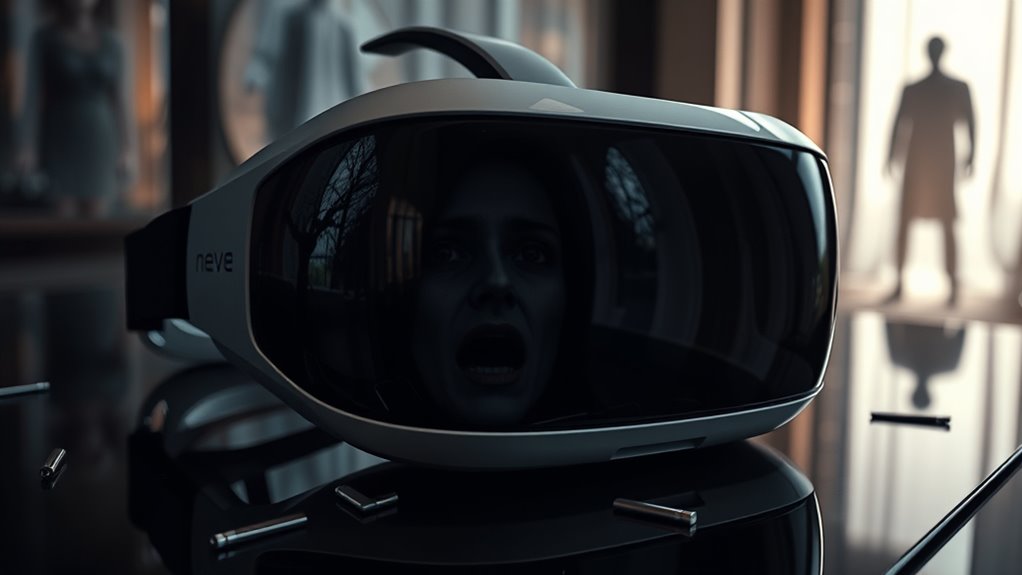To determine if the claims about a VR headset that can “kill” you are real, scrutinize the safety features and user reviews. Look for headsets with automatic shut-off and health monitoring systems, which indicate a focus on safety. Pay attention to red flags in marketing language and insist on transparency from manufacturers. Check expert opinions on potential risks. This careful analysis will help you assess the hype versus reality in VR technology, revealing more insights about safety and risks ahead.
Understanding the Concept of VR Headsets That “Kill”
Although the idea of a VR headset that “kills” may sound like something out of a sci-fi movie, it is essential to approach this concept with a critical eye. The notion stems from the intersection of virtual reality and immersive experiences, where the stakes can feel alarmingly real. While engaging in these environments, it’s important to understand that the technology can evoke intense emotional and physical responses.
The potential for psychological effects, especially in extreme scenarios, raises concerns about users’ wellbeing. A headset designed to simulate lethal consequences might exploit these reactions, blurring the line between reality and simulation. As freedom-loving individuals, you must prioritize safety and mental health when exploring such technologies. Always ask questions and stay informed to navigate this evolving landscape responsibly.
Analyzing the Technology Behind VR Safety Features
As virtual reality technology advances, understanding the safety features integrated into VR headsets becomes increasingly important. You need to scrutinize the safety standards set by regulatory bodies, as they dictate the minimum requirements for device safety. Look for headsets that incorporate breakthrough technology advancements like automatic shut-off mechanisms and health monitoring systems. These features can help mitigate risks associated with extended use or sudden movement. Additionally, consider the materials used in construction; hypoallergenic and durable materials can prevent physical harm. By being informed about these safety features, you can make educated choices that prioritize your freedom to explore virtual environments without compromising your well-being. Ultimately, vigilance in safety will empower you to enjoy VR experiences without fear.
Identifying Red Flags in VR Product Claims
How can you discern genuine claims from exaggerated marketing when it comes to VR products? First, scrutinize the language used in product descriptions. If it sounds overly sensational or includes phrases like “ultimate experience” or “never before seen,” approach with caution. Check for specific references to product safety; credible manufacturers will provide clear safety protocols or certifications. Investigate if the company has a history of transparency regarding virtual reality technology. Look for detailed explanations of features, rather than vague promises. Finally, be wary of products that promise to eliminate any risks; in technology, especially in virtual reality, there’s always a level of uncertainty. Prioritize informed choices and demand accountability from manufacturers to guarantee your safety.
Researching User Experiences and Expert Opinions
What do real users and experts say about a VR headset’s performance? To gauge the authenticity of a device, explore user reviews and expert interviews. Look for common themes in feedback—whether users mention discomfort, glitches, or immersion levels. Analyzing these experiences can reveal potential risks or hidden benefits.
Experts often provide insights into technical specs that might not be apparent to casual users. Their assessments can help clarify whether a headset’s claims hold water. Pay attention to any consistent warnings about safety or performance issues.
Establishing Safety Protocols for VR Gaming
User feedback and expert opinions provide valuable insights into the performance of VR headsets, but understanding the safety protocols for VR gaming is equally important. Establishing safety guidelines involves conducting a thorough risk assessment before you plunge into virtual experiences. Make certain your play area is clear of obstacles, guaranteeing you can move freely without hazards. Always use a safety strap on your headset to prevent accidental drops. Set time limits to avoid fatigue or disorientation, and take breaks to maintain your physical and mental well-being. If you’re gaming in a social environment, make certain everyone understands the boundaries to prevent collisions. Prioritizing these protocols not only enhances your experience but also safeguards your health and freedom during immersive gameplay.
Frequently Asked Questions
Can VR Headsets Really Cause Physical Harm in Real Life?
VR headsets can’t literally throw you into a blender, but they pose virtual reality risks. Always prioritize immersive technology safety to avoid accidents or injuries. Stay aware and take precautions while enjoying your digital adventures.
What Should I Do if I Experience Vr-Related Panic Attacks?
If you experience VR-related panic attacks, try grounding techniques, take breaks, and practice deep breathing. Developing VR coping mechanisms can help manage anxiety, while panic attack strategies like mindfulness can enhance your overall experience and freedom.
How Can I Report a Potentially Dangerous VR Product?
To report a potentially dangerous VR product, follow established reporting procedures. Document your experiences, gather evidence, and submit your findings to safety regulatory agencies, ensuring you adhere to safety guidelines to protect others and promote accountability.
Are There Legal Regulations for VR Headset Safety?
Just like a shield in battle, regulatory guidelines exist for VR headset safety, ensuring consumer protection. You should stay informed about these regulations to safeguard your freedom while enjoying immersive experiences without unnecessary risks.
What Are the Signs of VR Addiction or Overuse?
You might notice signs of VR addiction, like neglecting real-life responsibilities, experiencing virtual immersion effects, or developing gaming compulsions. If you feel anxious when away from VR, it’s time to reassess your usage.

